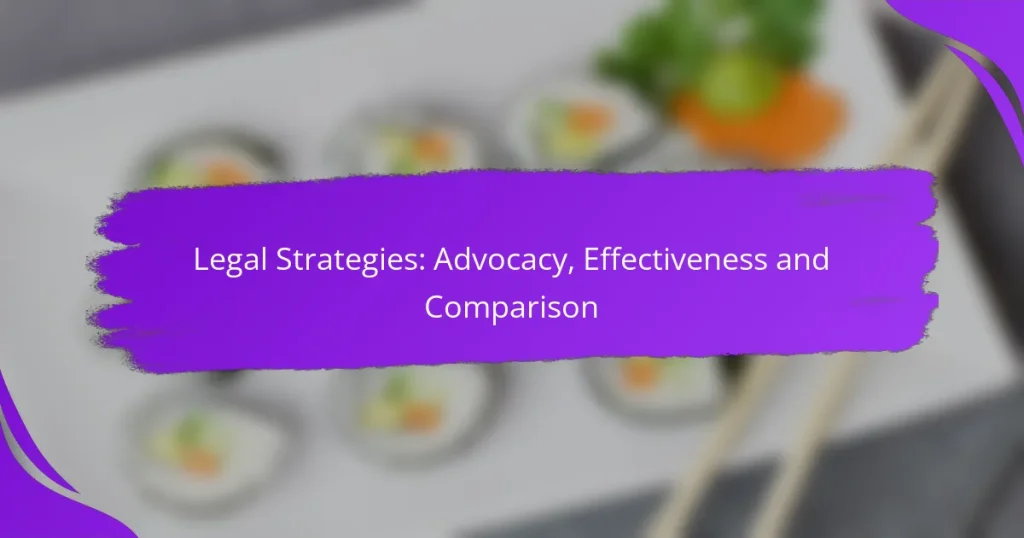Effective legal strategies for advocacy are essential for influencing decision-makers and securing favorable outcomes for clients or causes. By understanding the strengths and weaknesses of various approaches, such as litigation, mediation, and negotiation, individuals and organizations can select the most appropriate strategy tailored to their specific legal challenges. Key factors, including the nature of the legal issue and client objectives, play a crucial role in shaping these strategies.
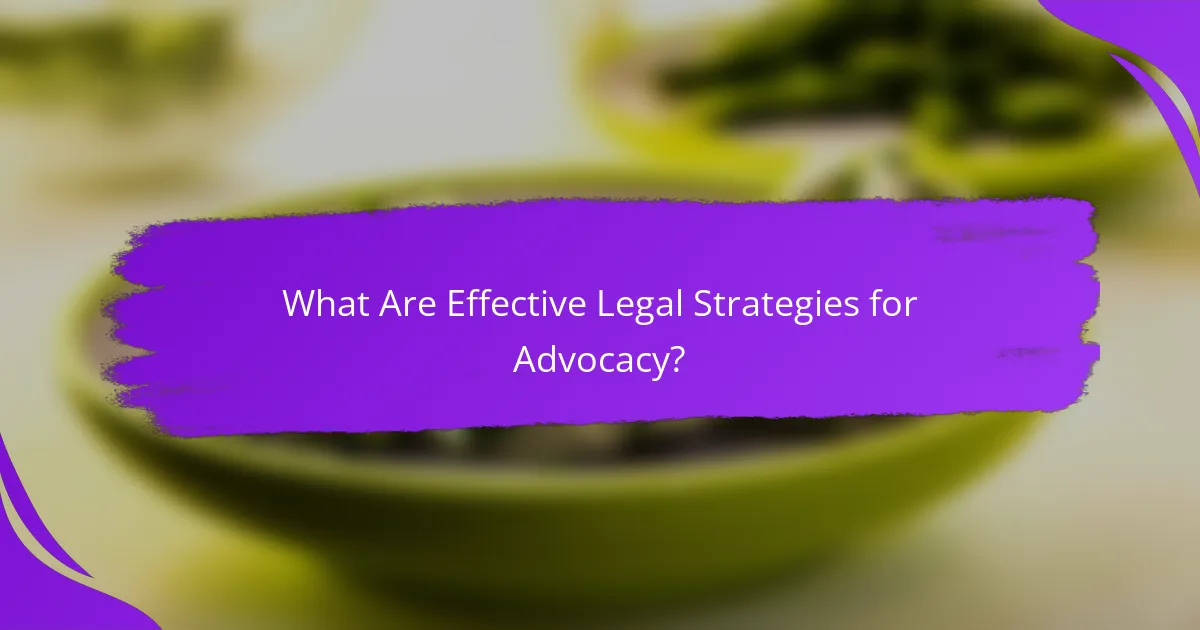
What Are Effective Legal Strategies for Advocacy?
Effective legal strategies for advocacy involve a range of approaches that aim to influence decision-makers and achieve favorable outcomes for clients or causes. These strategies can be tailored to specific situations, balancing factors such as cost, time, and the desired impact.
Litigation
Ligation is a formal legal process where disputes are resolved in court. This strategy is often used when other methods fail or when a legal precedent is necessary. It can be time-consuming and expensive, with costs potentially reaching thousands of dollars in legal fees.
When considering litigation, assess the strength of your case and the potential for a favorable ruling. Be prepared for a lengthy process that may involve discovery, motions, and trial. Understanding local court rules and procedures is crucial for effective advocacy.
Mediation
Mediation is a collaborative approach where a neutral third party helps disputing parties reach a mutually acceptable agreement. This strategy is generally less adversarial and can save time and costs compared to litigation.
In mediation, both parties present their positions, and the mediator facilitates discussion. It’s essential to choose a mediator with relevant experience. Successful mediation often requires flexibility and a willingness to compromise, making it suitable for many legal disputes.
Negotiation
Negotiation involves direct discussions between parties to reach a settlement without formal proceedings. This strategy can be effective in various contexts, from business deals to personal disputes, and often results in quicker resolutions.
Effective negotiation requires clear communication, understanding the interests of all parties, and a focus on win-win solutions. Prepare thoroughly by knowing your objectives and potential concessions. Avoid aggressive tactics that can lead to breakdowns in communication.
Public Interest Law
Public interest law focuses on legal advocacy for social justice and the protection of rights for marginalized groups. This strategy often involves litigation, policy advocacy, and community outreach to address systemic issues.
Attorneys in this field typically work for non-profit organizations or government agencies, aiming to influence legislation or public policy. Understanding the specific legal frameworks and regulations relevant to public interest cases is essential for effective advocacy.
Community Engagement
Community engagement involves collaborating with local groups and stakeholders to address legal issues affecting a community. This strategy emphasizes grassroots advocacy and mobilization to effect change at the local level.
Effective community engagement requires building trust and fostering relationships with community members. Organizing workshops, forums, or informational sessions can empower individuals to understand their rights and advocate for themselves. Consider leveraging social media and local networks to enhance outreach efforts.
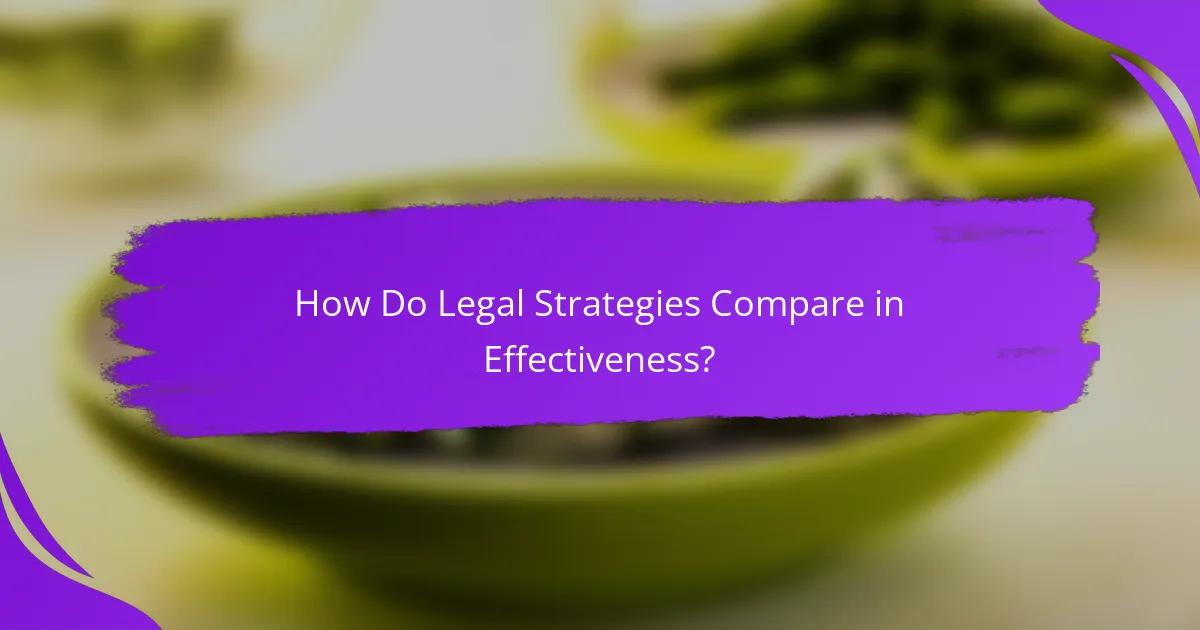
How Do Legal Strategies Compare in Effectiveness?
Legal strategies vary significantly in effectiveness based on the context and goals of the parties involved. Understanding the strengths and weaknesses of litigation, mediation, and negotiation can help individuals and organizations choose the most suitable approach for their legal challenges.
Success Rates of Litigation vs. Mediation
Ligation typically has a higher success rate in cases where legal precedents strongly support one party’s position. However, mediation often results in quicker resolutions and higher satisfaction rates among participants, as it encourages collaboration and compromise.
For example, in personal injury cases, litigation may yield larger settlements but can take years to resolve. In contrast, mediation can lead to agreements in a matter of weeks, making it a favorable option for many disputes.
Cost-Effectiveness of Negotiation
Negotiation is generally more cost-effective than litigation or mediation, as it avoids court fees and extensive legal expenses. Parties can save thousands of dollars by reaching an agreement directly without involving third parties.
It’s important to consider that while negotiation can be less expensive, it requires effective communication and negotiation skills. Engaging a skilled negotiator can enhance outcomes but may add to initial costs.
Time Efficiency of Public Interest Law
Public interest law often prioritizes time efficiency due to the urgent nature of many cases, such as those involving civil rights or environmental issues. Legal teams in this field frequently work to expedite processes to achieve justice for affected communities.
For instance, public interest lawsuits may be designed to address systemic issues quickly, often utilizing streamlined procedures that differ from traditional litigation. This approach can lead to faster resolutions, benefiting both the clients and the broader public interest.

What Factors Influence the Choice of Legal Strategy?
The choice of legal strategy is influenced by several key factors, including the type of legal issue, client objectives, and jurisdictional considerations. Understanding these elements helps in formulating an effective approach tailored to specific circumstances.
Type of Legal Issue
The nature of the legal issue significantly impacts the chosen strategy. For instance, criminal cases may require a more aggressive defense approach, while civil disputes often focus on negotiation and settlement. Identifying whether the matter is transactional, litigation-based, or regulatory will guide the strategic direction.
Different types of legal issues may also dictate the necessity for specialized knowledge. For example, intellectual property cases often require a deep understanding of patent law, while family law cases may involve emotional considerations that affect strategy.
Client Objectives
Client objectives play a crucial role in shaping legal strategy. Whether a client seeks to minimize financial liability, achieve a quick resolution, or set a legal precedent will influence the approach taken. Clear communication of these goals is essential for aligning the legal strategy with client expectations.
For example, a client focused on preserving a business relationship may prefer mediation over litigation, while another client aiming for a strong legal stance might opt for a more confrontational approach. Understanding these priorities can prevent misalignment and ensure effective representation.
Jurisdictional Considerations
Jurisdictional factors are vital in determining legal strategy, as laws and regulations can vary significantly between regions. Local legal standards, court procedures, and enforcement practices must be taken into account when developing a strategy. For instance, some jurisdictions may favor alternative dispute resolution methods, while others may have strict timelines for filing claims.
Additionally, understanding the local legal culture can influence strategy. In some areas, a collaborative approach may be more effective, while in others, a more adversarial stance may be necessary. Familiarity with local courts and judges can also provide strategic advantages in litigation.
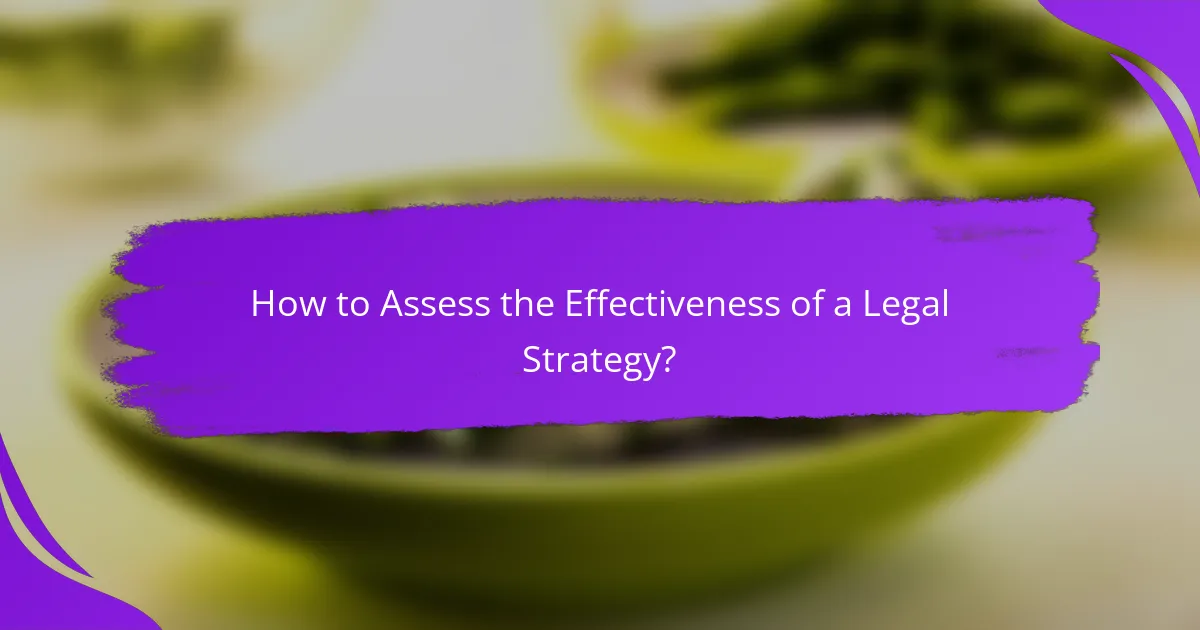
How to Assess the Effectiveness of a Legal Strategy?
To assess the effectiveness of a legal strategy, focus on measurable outcomes, client feedback, and comparative analyses. These elements provide a comprehensive view of how well a strategy meets its objectives and satisfies client needs.
Outcome Metrics
Outcome metrics are quantifiable indicators that reflect the success of a legal strategy. Common metrics include win rates, settlement amounts, and time to resolution. For example, a strategy that consistently achieves favorable settlements within a few months may be deemed effective.
When evaluating outcome metrics, consider the context of each case, including the complexity and jurisdiction. A strategy that works well in one legal environment may not yield the same results in another.
Client Satisfaction Surveys
Client satisfaction surveys gather direct feedback from clients about their experiences with legal services. These surveys often include questions about communication, perceived value, and overall satisfaction with the legal outcome. High satisfaction scores can indicate an effective legal strategy.
To maximize the usefulness of these surveys, ensure they are conducted shortly after case resolution. This timing helps capture accurate impressions while the experience is fresh in clients’ minds.
Case Study Comparisons
Case study comparisons involve analyzing similar cases to evaluate the effectiveness of different legal strategies. By examining outcomes, approaches, and client feedback from various cases, legal professionals can identify best practices and areas for improvement.
When conducting case study comparisons, focus on cases with similar legal issues and contexts. This ensures that the insights gained are relevant and applicable to future strategies. Consider creating a simple table to summarize key findings from different cases for easy reference.
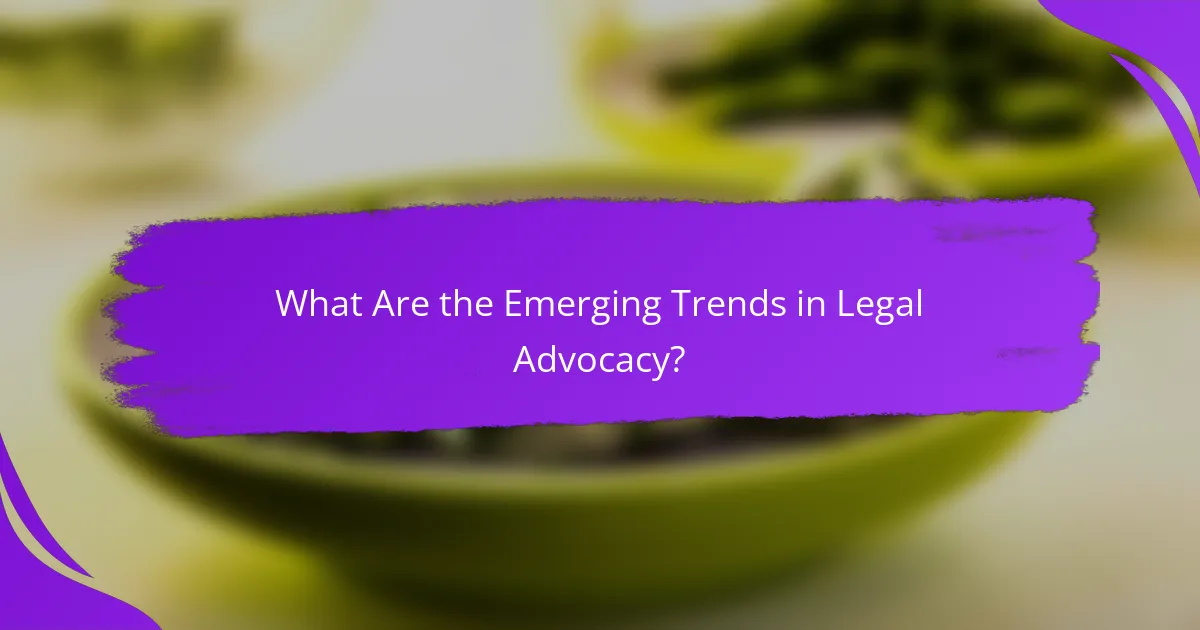
What Are the Emerging Trends in Legal Advocacy?
Emerging trends in legal advocacy are reshaping how lawyers approach cases and engage with clients. Key developments include the integration of technology, a heightened focus on social justice issues, and increased collaboration with nonprofit organizations.
Technology in Legal Strategies
Technology is revolutionizing legal advocacy by streamlining processes and enhancing communication. Tools such as case management software, artificial intelligence for legal research, and virtual courtrooms are becoming standard practice, allowing lawyers to operate more efficiently.
For instance, AI can analyze large volumes of documents in a fraction of the time it would take a human, significantly reducing costs. Law firms should consider investing in these technologies to stay competitive and improve client service.
Increased Focus on Social Justice
The legal field is increasingly prioritizing social justice, with many advocates working to address systemic inequalities. This trend involves not only representing marginalized communities but also engaging in policy reform and public education efforts.
Lawyers are now more likely to take on pro bono cases that align with social justice causes, which can enhance their reputation and attract clients who value corporate social responsibility. Engaging with community organizations can also amplify these efforts.
Collaboration with Nonprofits
Collaboration between legal professionals and nonprofit organizations is on the rise, allowing for a more holistic approach to advocacy. These partnerships can provide legal aid to underserved populations and amplify the impact of advocacy efforts.
For example, lawyers can work with nonprofits to tackle issues like housing rights or immigration reform, leveraging the nonprofit’s grassroots connections and expertise. This synergy not only helps clients but also fosters a sense of community engagement and shared mission.
